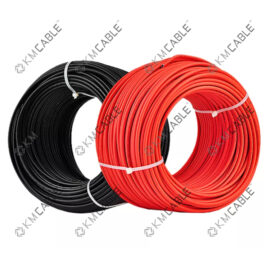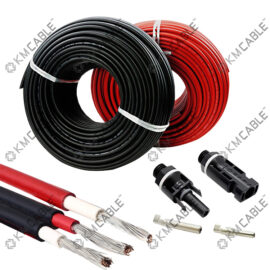
| Brand | KMCable |
|---|---|
| Core | Single Core |
| Conductor | copper |
| Color | Black, Red |
| Nominal voltage U0/U | AC : 1,0/1,0 kV DC : 1,5/1,5 kV |
| Temperature (°C) - flexing | -40°C to +90°C |
| MOQ | 500meter |

| Weight | 30 kg |
|---|---|
| Dimensions | 45 × 30 × 30 cm |
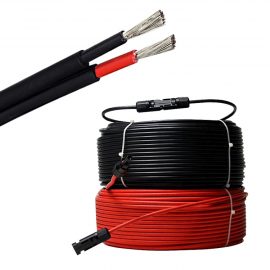
| code | Single Core |
|---|---|
| Color | customized |
| MOQ | 500meter |
| Conductor | copper |
| Temperature (°C) - flexing | -40°C to +90°C |
| Core | Single Core |
| Nominal voltage U0/U | AC : 1,0/1,0 kV DC : 1,5/1,5 kV |

| Brand | KMCable |
|---|---|
| Core | Single Core |
| Conductor | copper |
| Color | Black, Red |
| Nominal voltage U0/U | AC : 1,0/1,0 kV DC : 1,5/1,5 kV |
| Temperature (°C) - flexing | -40°C to +90°C |
| MOQ | 500meter |
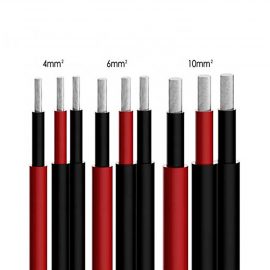
| code | Single Core |
|---|---|
| Color | customized |
| MOQ | 500meter |
| Nominal voltage U0/U | AC : 1,0/1,0 kV DC : 1,5/1,5 kV |
| Conductor | copper |
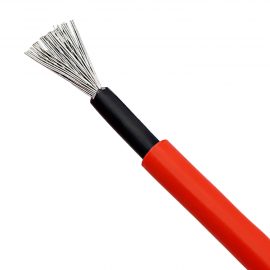
| Conductor | copper |
|---|---|
| Color | Gray |
| MOQ | 500meter |
| Nominal voltage U0/U | AC : 1,0/1,0 kV DC : 1,5/1,5 kV |
| Temperature (°C) - fixed | -40 to +80℃ |
| Temperature (°C) - flexing | -40°C to +90°C |
Solar Cable
Solar technologies convert sunlight into electrical energy either through photovoltaic (PV) panels or through mirrors that concentrate solar radiation.
A photovoltaic system employs solar modules, each comprising several solar cells that generate electrical power. PV installations may be ground-mounted, rooftop-mounted, wall-mounted or floating. The mount may be fixed or use a solar tracker to follow the sun across the sky.
Photovoltaic systems are a crucial component of renewable energy production. They convert the sun’s energy into electricity that can be used to power homes and businesses. Solar cables play a vital role in the efficient and safe operation of these systems, connecting solar panels to the inverter and transmitting electricity. That’s why choosing the right solar cable is an important decision that can impact the performance and lifespan of your photovoltaic system.
KMcable is a leading manufacturer of high-quality solar cables for photovoltaic systems. Our expert team is dedicated to providing the best products and services to help you achieve maximum performance and efficiency from your PV system.
What are Solar Cables (PV Cables)?
Solar cables, also known as PV cables, are specifically designed for use in photovoltaic systems. They are made from high-quality materials and are rated for both voltage and temperature, ensuring safe and efficient operation. There are several types of solar cables, including single-core, multicore, and multicore shielded cables, each with their own specific features and applications.
KMcable offers a range of solar cables to meet your specific needs. Our products are designed to withstand harsh weather conditions and are certified to international standards, ensuring reliable performance and peace of mind.
Types of Solar PV Cables
There are several types of solar PV cables available, but two of the most common types are PV1-F cable and H1Z2Z2-K cable.
PV1-F cable is a single-core, double-insulated cable that is designed to be flexible and easy to install. PV1-F cable is often used in smaller-scale solar PV systems, such as residential systems.
H1Z2Z2-K cable is a multi-core, double-insulated cable that is designed to be more durable and resistant to wear and tear than PV1-F cable. H1Z2Z2-K cable is often used in larger-scale solar PV systems, such as commercial or industrial systems.
When choosing between PV1-F and H1Z2Z2-K cable, it’s important to consider the specific needs of your system, such as the voltage and current requirements, the length of the cable runs, and the environmental conditions in which the cable will be installed.
Differences between Solar PV Cable and Normal Cable
One of the main differences between solar PV cable and normal electrical cable is the insulation and sheath materials used. Solar PV cable is designed to withstand the harsh environmental conditions often found in outdoor solar PV installations, such as high temperatures, UV radiation, and moisture.
Another key difference between solar PV cable and normal cable is the temperature ratings of the cable. Solar PV cable is typically rated for use in temperatures ranging from -40°C to 90°C, while normal electrical cable may not be able to withstand such extreme temperatures.
Key Considerations When Choosing Solar Cables
When choosing solar cables for your photovoltaic system, there are several key factors to consider. Firstly, it’s important to choose a cable that is the right size for your system and has a suitable voltage rating. Secondly, the cable must be able to operate in the temperature range of your specific location, and have the necessary durability to withstand any environmental conditions. Additionally, it’s important to understand cable standards and certifications, such as TÜV, UL, and CE, to ensure that the cable you choose meets international safety and performance standards.
KMcable’s expertise and attention to detail means that we can help you choose the right solar cable for your needs. Our team will work with you to determine the right cable size, voltage rating, temperature range, and other requirements, ensuring that your photovoltaic system operates efficiently and safely.
Advantages of Using High-Quality Solar Cables
Investing in high-quality solar cables for your photovoltaic system can have a significant impact on its performance and lifespan. Firstly, using high-quality cables can improve the efficiency of your system, as well as increase its safety. Secondly, using high-quality cables can also improve the performance of your solar panels and other components, ensuring they last longer. Thirdly, peace of mind and reduced maintenance costs are additional benefits of choosing high-quality solar cables.
Solar cables are an essential component of photovoltaic systems, connecting solar panels to the inverter and transmitting electricity. Choosing the right solar cable is important, as it can impact the efficiency, safety, and lifespan of your system. KMcable is a leading manufacturer of high-quality solar cables for photovoltaic systems, offering expert advice, reliable products, and exceptional customer service.
Frequent asked questions
What is the difference of solar PV cable pv1 f and H1Z2Z2 K?
PV1-F and H1Z2Z2-K are two different types of solar PV cable with some key differences.PV1-F cable is a single-core, double-insulated cable that is designed to be flexible and easy to install. It is often used in smaller-scale solar PV systems, such as residential systems.
H1Z2Z2-K cable, on the other hand, is a multi-core, double-insulated cable that is designed to be more durable and resistant to wear and tear than PV1-F cable. It is often used in larger-scale solar PV systems, such as commercial or industrial systems.
The main differences between these two types of cable are their construction and performance characteristics. PV1-F cable is more flexible and easier to install than H1Z2Z2-K cable, but it may not be as durable or able to handle as high of a current as H1Z2Z2-K cable. H1Z2Z2-K cable, on the other hand, is designed to be more durable and capable of handling higher currents, but may be more difficult to install due to its less flexible construction.
When choosing between PV1-F and H1Z2Z2-K cable, it’s important to consider the specific needs of your system, such as the voltage and current requirements, the length of the cable runs, and the environmental conditions in which the cable will be installed.
How many amps can 4mm and 6mm solar cable take?
The amount of current that a solar cable can handle depends on several factors, including the cable’s gauge (i.e., diameter), the length of the cable run, and the environmental conditions in which the cable is installed.In general, a 4mm solar cable can handle up to 41 amps of current, while a 6mm solar cable can handle up to 57 amps of current. However, it’s important to note that these are general guidelines and the actual current capacity of a cable will depend on the specific factors mentioned above.
When selecting a solar cable for your system, it’s important to choose a cable that is appropriately sized for the amount of current that will be flowing through it. It’s also important to ensure that the cable is rated for the voltage of your system and that it meets any applicable safety and performance standards.
What does MC4 mean in solar and what is mc4 cable?
MC4 is a type of connector used in solar PV systems to connect solar panels to each other or to other components of the system, such as inverters or combiner boxes. The MC4 connector is named for the manufacturer Multi-Contact, which designed and produced the connector.An MC4 connector consists of a male and female connector that can be easily connected and disconnected to facilitate installation, maintenance, and repair of the system. The MC4 connector is designed to be weatherproof and resistant to UV radiation, making it suitable for use in outdoor environments.
MC4 cables are cables that are designed to be used with MC4 connectors. They typically have two conductors (positive and negative) and are double-insulated for durability and safety. The cables are typically made from copper or aluminum and are available in different gauges (diameters) to suit different applications and current requirements.
When using MC4 cables and connectors in a solar PV system, it’s important to ensure that the cables are rated for the voltage and current of the system, and that they meet any applicable safety and performance standards. It’s also important to follow proper installation procedures and to use appropriate tools and equipment to ensure a safe and reliable connection.
What gauge cable do I need for solar panels?
The gauge (or diameter) of the cable you need for your solar panels will depend on several factors, including the maximum current rating of the panels, the length of the cable run, and the environmental conditions in which the cable will be installed.As a general rule, the following cable gauges are recommended for typical solar panel installations:
- For panels with a maximum current rating of up to 15 amps, use 14-gauge cable.
- For panels with a maximum current rating of up to 25 amps, use 12-gauge cable.
- For panels with a maximum current rating of up to 40 amps, use 10-gauge cable.
- For panels with a maximum current rating of up to 60 amps, use 8-gauge cable.
- For panels with a maximum current rating of up to 80 amps, use 6-gauge cable.
- For panels with a maximum current rating of up to 120 amps, use 4-gauge cable.
It’s important to note that these are general guidelines and the specific cable gauge you need may vary based on the factors mentioned above. It’s always a good idea to consult with a qualified electrician or solar installer to determine the appropriate cable gauge for your specific system.
Contact us
Kmcable is a leading manufacturer of high-quality solar cables designed to provide exceptional performance and durability in photovoltaic systems. The company specializes in producing solar cables that meet international standards for safety and efficiency, making them suitable for use in a variety of solar power applications. With a focus on quality and reliability, Kmcable uses advanced technologies and materials to produce solar cables that are resistant to extreme weather conditions, UV radiation, and moisture. Their products are designed to withstand harsh outdoor environments and ensure the smooth and efficient operation of solar power systems. Kmcable is commitment to sustainability and innovation has made them a trusted partner in the solar energy industry, providing customers with reliable, cost-effective, and eco-friendly solutions for their energy needs
Categories
- 0.6/1 kv Power Cable (17)
- LS0H/LSZH cable (2)
- PVC Cable (3)
- Rubber Cable (9)
- XLPE cable (4)
- Automotive wire (39)
- American standard wire (9)
- Car Battery Cable (34)
- Euro standard wire (12)
- EV Cable (8)
- Japanese standard wire (7)
- Coil cable (34)
- PUR cable (12)
- PVC cable (3)
- Rubber cable (9)
- Spiral cable assembly (10)
- Flexible control cable (2)
- Genie Parts (5)
- Industrial Wire Cable (33)
- CCC wire (5)
- CE Cable (3)
- Data cable (6)
- Drag chain cable (7)
- Robot cable (2)
- Servo cable (3)
- Special cable (3)
- UL wire (3)
- Media Cable (5)
- Microphone Cable (1)
- Speaker cable (4)
- Other (4)
- Ready to Ship (23)
- Single Core Cable (21)
- CE certificated cable (7)
- Drag chaine cable (2)
- Photovoltaic cable (5)
- PUR flexible cable (3)
- Solar Cable (7)
- UL certificated cable (3)
- Trailer Truck Cable (26)
- Coil Cable Assembly (16)
- Trailer cable (10)
- Wire harness for industry (7)
Producer
Price

As direct sale from our factory, we offer bellow benefits:
- Best price on the market guaranteed !
- The option to modify the product, such as the color, the length, you name it!

